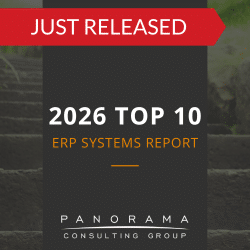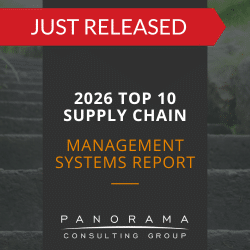Key Takeaways
- Many manufacturers still lack real-time production visibility despite significant digital transformation investments.
- Fragmented systems, inconsistent data governance, and limited real-time context continue to undermine manufacturing visibility.
- ERP systems alone cannot provide reliable shop-floor insights; integrated data, processes, and governance are essential.
- Executives can close the visibility gap by assessing current capabilities, prioritizing key integrations, and strengthening governance.
Despite years of digital transformation initiatives, many manufacturers still struggle to answer a basic operational question in real time: What exactly is happening on the production floor right now?
Advanced ERP systems, IoT-connected machines, and smart factory investments promised a new era of operational insight. Yet across manufacturing environments, executives continue to face production visibility issues that delay decisions, obscure root causes, and weaken supply chain performance.
This post explores why digital transformation struggles to deliver on the promise of manufacturing visibility, and what executives can do to close the gap.
Contemplating litigation?
We have multiple software expert witnesses available for provision of reports, depositions, and testimonies.
Why ERP Alone Hasn’t Solved Production Visibility
ERP systems are designed to centralize business operations. They excel more at transactional processing than continuous data collection from the shop floor.
This limitation has led many manufacturers to layer ERP systems with SCM software to fill the visibility gap. However, unless these platforms are well-integrated, adding more tools often introduces new blind spots.
The Visibility Paradox: More Systems, Less Clarity
Most manufacturers have invested in digital technologies to improve production oversight, but the results have been mixed. Visibility challenges remain persistent even after large-scale ERP implementations.
This is because production visibility does not come from deploying more systems. It comes from connecting the right data, people, and processes. And this is precisely where many digital transformation efforts fall short.
The shop floor generates an overwhelming volume of data. However, without well-governed integration and context, this data becomes noise. Executives may receive regular reports, but these often fail to capture the nuances of daily operations.
Real World Example
A healthcare manufacturing company experienced a similar challenge with its accounting and manufacturing operations remaining decentralized across global locations. Each facility followed different workflows, leading to operational disconnects and inconsistent data.
By selecting the right ERP system, the organization achieved real-time global visibility and more consistent master data management. These improvements helped reduce process inefficiencies that had previously made cross-site performance difficult to monitor.
Causes of Production Visibility Issues
The root causes of visibility issues often fall into three categories:
1. Siloed Systems
Digital transformation efforts often operate in silos. Engineering teams implement predictive maintenance tools. Quality teams use standalone analytics dashboards. Finance relies on ERP data.
The result is fragmented insight where each system provides a partial view, but no one sees the whole picture.
2. Inconsistent Data Governance
Different business units may define the same metrics differently. Meanwhile, machine-generated data may conflict with human-entered production logs. Organizations in this situation must establish centralized ownership of data quality and access.
Otherwise, manufacturing analytics challenges will compound over time and trust in data will erode as visibility declines.
3. Lack of Real-Time Context
Even with integrated systems, visibility often lacks immediacy. Many dashboards show historical trends rather than live operational signals. Operators may flag exceptions, but escalation paths are unclear. Managers make decisions based on outdated snapshots, reducing the effectiveness of real-time responsiveness.
These issues plague both discrete and process manufacturers, although they often manifest differently:
- In discrete manufacturing, the challenge may involve tracking serialized components across production lines.
- In process industries, it may mean tracing raw material inputs through complex batch recipes.
In both cases, the visibility problem is less about technology and more about coherence across the data lifecycle.
Strategic Recommendations for Executives
For C-level leaders, these persistent production visibility issues are strategic risks. Poor visibility undermines agility, delays innovation, and erodes competitiveness. It also creates exposure in areas such as compliance, customer satisfaction, and cost control.
To address this, executives must reframe visibility as a business capability. That means treating visibility as a cross-functional objective that requires executive sponsorship, process redesign, and robust data governance.
1. Conduct a Visibility Capability Assessment
Before investing in new technology, conduct an internal visibility audit. Where do decisions stall? Where do teams work from outdated or conflicting reports? Which production metrics are delayed or disputed?
A business software consultant can help you map your current systems and processes against your visibility goals, identifying disconnects in data flow, process handoffs, and user access.
2. Prioritize Integration Around Critical Use Cases
Not every integration needs to happen at once. Instead, identify high-value production scenarios where visibility directly impacts cost, quality, or customer outcomes. Then build targeted integrations between ERP and SCM software to enable real-time insights.
3. Build Governance Into Your Digital Stack
Manufacturing analytics challenges often stem from poor governance, not technology gaps. Executives should assign data stewards to key domains (inventory, production, quality) and ensure that roles, definitions, and data usage are standardized across systems.
4. Use Vendor-Neutral Guidance During Selection
Many manufacturers rely on ERP vendors or SCM vendors to define their data strategy. However, these vendors are often incentivized to prioritize their platforms’ strengths rather than your specific operational needs.
An independent ERP expert can help your team select platforms that reflect your actual manufacturing complexity. That means asking harder questions during the software selection phase and pressure-testing how well platforms support visibility use cases in real-world scenarios.
Learn More About Production Visibility in Manufacturing
Digital transformation has moved the needle in many areas of manufacturing, but production visibility remains a stubborn blind spot.
As an independent ERP consulting firm, we help manufacturers navigate these challenges with vendor-neutral guidance and deep operational expertise. Whether you are building an ERP software list or rethinking your data strategy, our team can help you define a path that delivers clarity. Contact us below to learn more.















